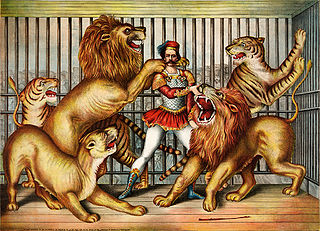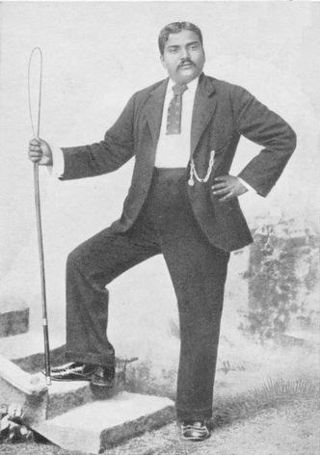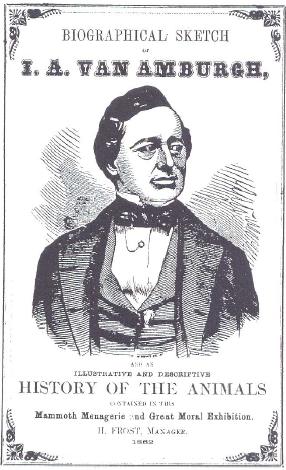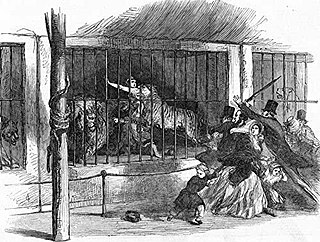Chiarini's Royal Italian Circus and Performing Animals, also known as Chiarini's Circus and Menagerie or simply the Royal Italian Circus (Italian : Circo Italiano) was a renowned traveling circus company.
Chiarini's Royal Italian Circus and Performing Animals, also known as Chiarini's Circus and Menagerie or simply the Royal Italian Circus (Italian : Circo Italiano) was a renowned traveling circus company.
Italian-born equestrian Giuseppe Chiarini established the international circus company as the director.
The circus first traveled across America in the mid-19th century and then started abroad. In 1855, Chiarini's Italian Circus performed in Greenville, Ohio. [1] Chiarini began touring Cuba in 1856 under the banner of the Royal Spanish Circus. He later adopted Chiarini's Royal Italian Circus, serving as the company's manager and proprietor. [2] In 1859, a wooden circus was provisionally opened in Havana for Smith & Chiarini's equestrian troupes. [3] In 1863, Chiarini's circus company in Havana performed at Plaza de Armas. In January 1867, Chiarini's circus headed to Mexico. After an eleven-week run in San Francisco, Chiarini advertised more shows on the Californian tour in 1868, including Sacramento, Stockton, and Marysville. [4] The circus had left for Panama and the cities of South America by steamer in 1869. [5]
During a visit to Auckland, New Zealand, in January 1873, the circus company held an event. [6] [7] Chiarini's company landed in Melbourne in March 1873, arriving from New Zealand. On October 8, 1874, the troupe performed in Yokohama, Japan. [8] In November 1879, returned to New Zealand in Wellington. [9]
In 1880, the troupe consisted of an American bison, two zebras, three full-grown Bengal tigers, three tiger cubs, eight performing dogs, over twenty well-trained horses, and six trick ponies. [10]
Chiarini's Royal Italian Circus and Performing Animals appeared in Singapore in 1882. [11] A performance in front of the Maharajah of Johor, whose state was located directly to the north of Singapore's Crown Colony, took place on January 30, 1883. [12]
The troupe made an appearance in Adelaide, Australia, in 1884. [13]
According to records, negotiations for the sale of Chiarini's menagerie and circus animals were underway with Chinese parties in 1889. [14] Following a journey to Shanghai, just two elephants, twenty-three horses, fourteen ponies, two jacks, two goats, four monkeys, one brahma, and a large number of pigeons remained in the menagerie after part of it was sold. [15]
The famed circus which travelled the world no longer existed upon Chiarini's death in 1897 in Panama City, Panama.

A circus is a company of performers who put on diverse entertainment shows that may include clowns, acrobats, trained animals, trapeze acts, musicians, dancers, hoopers, tightrope walkers, jugglers, magicians, ventriloquists, and unicyclists as well as other object manipulation and stunt-oriented artists. The term circus also describes the field of performance, training and community which has followed various formats through its 250-year modern history. Although not the inventor of the medium, Newcastle-under-Lyme born Philip Astley is credited as the father of the modern circus.

Phineas Taylor Barnum was an American showman, businessman, and politician remembered for promoting celebrated hoaxes and founding with James Anthony Bailey the Ringling Bros. and Barnum & Bailey Circus. He was also an author, publisher, and philanthropist, although he said of himself: "I am a showman by profession ... and all the gilding shall make nothing else of me." According to Barnum's critics, his personal aim was "to put money in his own coffers". The adage "there's a sucker born every minute" has frequently been attributed to him, although no evidence exists that he had coined the phrase.

The Ringling Bros. and Barnum & Bailey Circus, also known as the Ringling Bros. Circus, Ringling Bros., the Barnum & Bailey Circus, Barnum & Bailey, or simply Ringling, is an American traveling circus company billed as The Greatest Show on Earth. It and its predecessor have run shows from 1871, with a hiatus from 2017 to 2023. They operate as Ringling Bros. and Barnum & Bailey. The circus started in 1919 when the Barnum & Bailey's Greatest Show on Earth, a circus created by P. T. Barnum and James Anthony Bailey, was merged with the Ringling Bros. World's Greatest Shows. The Ringling brothers purchased Barnum & Bailey Ltd. in 1907 following Bailey's death in 1906, but ran the circuses separately until they were merged in 1919.

A menagerie is a collection of captive animals, frequently exotic, kept for display; or the place where such a collection is kept, a precursor to the modern zoo or zoological garden.

John Boyden Adams was a famous California mountain man and trainer of grizzly bears and other wild animals he captured for menageries, zoological gardens and circuses.

Lion taming is the taming and training of lions, either for protection or for use in entertainment, such as the circus. The term often applies to the taming and display of lions and other big cats such as tigers, leopards, jaguars, black panthers, cheetahs, and cougars. People often use lion taming as a metaphor for any dangerous activity. Lion taming occurs in zoos around the world to enable the keepers to carry out medical procedures and feedings.

Adam John Forepaugh was an American horse trader and circus owner. From 1865 through 1890 his circus operated under various names including Forepaugh's Circus, Forepaugh's Gigantic Circus and Menagerie, The Forepaugh Show, 4-PAW Show, The Adam Forepaugh Circus, and Forepaugh & The Wild West.

Captain Frederick Wollaston Hutton was an English-born New Zealand scientist who applied the theory of natural selection to explain the origins and nature of the natural history of New Zealand. Whilst an army officer, he embarked on an academic career in geology and biology, to become one of the most able and prolific nineteenth century naturalists of New Zealand.

The Exeter Exchange was a building on the north side of the Strand in London, with an arcade extending partway across the carriageway. It is most famous for the menagerie that occupied its upper floors for over fifty years, from 1773 until the building was demolished in 1829.

A public aquarium (pl. aquaria) or public water zoo is the aquatic counterpart of a zoo, which houses living aquatic animal and plant specimens for public viewing. Most public aquariums feature tanks larger than those kept by home aquarists, as well as smaller tanks.

Priyanath Bose also known as Professor Bose was an Indian circus performer and entrepreneur. In 1887 he founded The Great Bengal Circus with an all-Indian team and toured Bengal, India and South East Asia. He is considered to be one the pioneers of circus in India.

Isaac A. Van Amburgh (1808–1865) was an American animal trainer who developed the first trained wild animal act in modern times. By introducing jungle acts into the circus, Van Amburgh paved the way for combining menageries with circuses. After that, menageries began using equestrian and clown performances in circus rings. Gradually the distinction between circus and menagerie faded.

Martini Maccomo was a lion tamer in Victorian Britain. He performed with William Manders' menagerie from around 1854 and remained the group's key attraction until his death. His act involved pursuing lions and tigers around a cage utilising whips, pistols and knuckledusters. The performances were renowned for their danger, and attacks on Maccomo by the animals were often reported on in newspapers. He was portrayed as a noble savage with stereotypical "African" dress, although he later moved away from this characterization. He was known for his coolness of nerve in the ring and his mild-mannered nature outside it. Maccomo died in Sunderland in 1871.

Ellen Eliza Blight (1833–1850), also known as Helen Bright, was an English lion tamer, known as "The Lion Queen", who was killed by a tiger while working in her uncle George Wombwell's menagerie, aged 17. Her shocking death made her a media sensation.

Although street performances similar to circuses have existed in India since ancient times, a circus similar to the one described by Philip Astley, known as the father of the modern circus, as described in 1770, only existed in India in the 1880s.
Vishnupant Moreshwar Chatre (1840-1905) was an Indian circus owner who is considered the founder of the modern Indian circus. His circus company Great Indian Circus was the first circus company in India. Chatre met martial arts trainer Keeleri Kunhikannan when Great Indian Circus toured Thalassery, Kerala in 1887. In this visit an agreement was signed between Keeleri Kunjikannan and Chatre, according to that Keeleri Kunjikannan agreed to train the trainees for the circus and Chatre agreed to employ them. This led to the development of first circus academy in the country.

Francis Charles Bostock (1866–1912) was an English entrepreneur and animal trainer, who represented the touring section of the Bostock and Wombwell Menagerie. He toured Europe and America and in the latter he was known as "The Animal King". At death he was called "England's Greatest Showman".

Wirth's Circus, also known as Wirth Brothers' Circus, was Australia's largest and most prestigious circus company for eight decades. Billed as Australia's own 'Greatest show on Earth', the travelling circus held an international reputation.
Giuseppe Chiarini was an Italian equestrian, horse trainer, and international circus owner.
Sara Houcke, also known as The Tiger Whisperer, is a professional animal tamer who began working for the "Greatest Show on Earth" program at the Ringling Bros. and Barnum & Bailey Circus in 1999. Born into a centuries-old family of circus performers, she began training from a young age in various forms of circus acts. She joined a German circus upon reaching adulthood before becoming a multi-year tiger and elephant trainer at the Ringling Bros. Circus. Later, she joined the Grand Cirque de Saint Petersburg in the early 2010s and has remained caretaker of the animal menagerie and performer since.